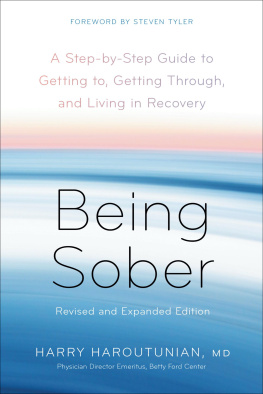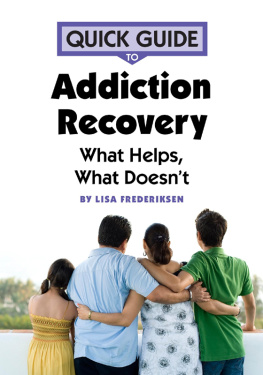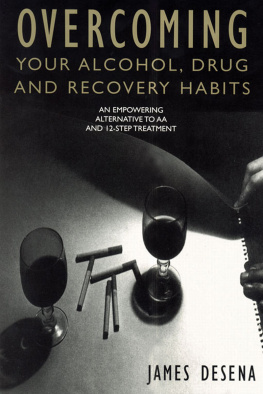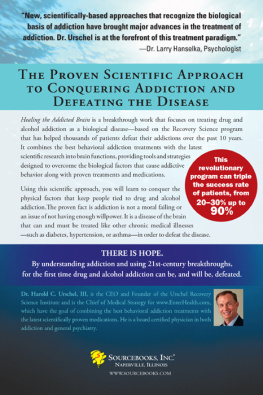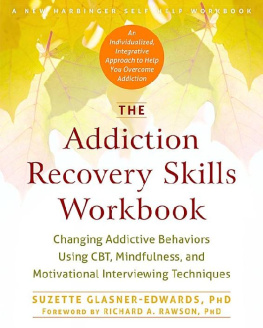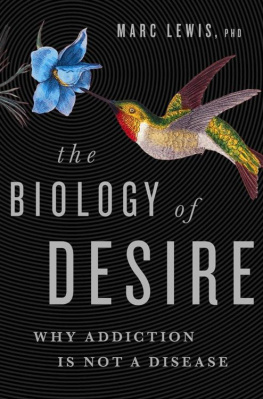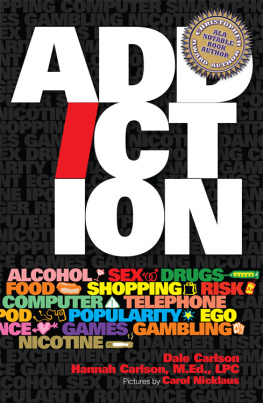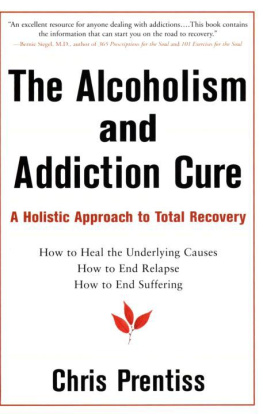Contents
Landmarks
Print Page List
Acknowledgments
First and foremost, I would like to thank the people who were instrumental in getting this book to printmy brilliant agent, Linda Konner; Karen Chernyaev, who helped to piece the manuscript together; as well as Cheryl LaFlamme, for her untiring support and patience. Without them, this book might not have reached the electric and engaging folks at Rodale Inc., especially Ursula Cary.
In the addictions arena, its important for me to acknowledge Terence Gorski; Rabbi Abraham Twerski, MD; Hazelden; and particularly the Betty Ford Center for their enormous contributions to the body of knowledge in the addiction field. To those beautiful people who supported me through those tough times: My gratitude can never be expressed to my nurse, Simone, who was with me for 25 years, or to the absolute saint Valery Yandow, MD, who was my mentor and guide during those early years of sobriety. Miki Boni, who, in a heartbeat, attended my Family Program at the Betty Ford Center when no one else could come, has always been my sister (even though we arent truly related).
There are so many other people to thanktoo numerous to list herewho are in my heart and my prayers on a daily basis. These are the ones who had the courage to say that something was wrong even when I could not listen and could not see. They all know who they are. They remain my closest and most trusted friends. I had some wonderful angels in my life to help me along the way, the heroes in my recovery. These are people to whom I owe my life.
And I cant leave out the men who began the program that saved my life. Because of Bill W. and Dr. Bob, founders of Alcoholics Anonymous, I learned that giving it up is the key, the missing partthe surrender that has brought me this windfall of grace. And, finally, to my beloved patients at the Betty Ford Center and the great patients of Vermont: Weve shared our strengths and hopes together, getting through this thing one day at a time. I have so much gratitude toward all of you and for all that youve done for me.
CHAPTER 1
The Disease of Addiction
Every day I thank God for inventing the blackout, without which I would have drunk myself to death.
Anonymous
I drove home one cold November night through the mountains of Vermont. My moment of spiritual awakening came like Bill W.s, the cofounder of Alcoholics Anonymous, who describes his moment of spiritual awakening in the form of a bright white lightonly for me the light was blue and in my rearview mirror.
When the rookie cop got out of his patrol vehicle and walked up to my car, I thought I recognized him. He could have been a pediatric patient of mine, now grown up in jackboots and a Smokey hat. He told me that I had been wandering between the lines. I said, Well, I thought thats where I was supposed to bebetween the lines, that is.
I then did what any other red-blooded American alcoholic might do having the time, knowledge, and inclination: I blew out the side of my mouth so his Breathalyzer test wouldnt work and so I could buy myself some time. On the way to the police station, I faked a hypoglycemic attack to bring out the entire rescue squad so they would become witnesses who could help explain my behavior. This would look good in court, I told myself.
Then I hired a detective. We went back to the scene of the crime and videotaped all the stripes on that highway and saw that some of those stripes wiggled and varied, a scenario that could give rise to the theory that it had only been an optical illusion that my car had been weaving. It also pointed to the possibility that the Vermont road crew who painted the lines was loaded at the time. As if that werent enough, I hired a chemist to refute my blood alcohol level reading by explaining that at that temperature and at that time, in the middle of the night, and given the toothpaste I was using, all tests were, in all probability, invalid.
After examining the arrest record of this young cop, the detective and I determined he was probably a stalker who had followed many a bar employee home, stopping them and forcing them into DUI checks. I was just another victim. So we amassed a lot of evidence, and I spent a fortune because there was no way a guy like me was going to go down. I was a doctor with the gift of defiance and grandiosity, the perfect storm for an alcoholic.
We were preparing for trial when my lawyer said, Hey, Doc, before we go to trial, would you like to see the videotape?
What videotape?
The videotape of your arrest that was made by the chief of police who was training the rookie cop. The chief, whos known you for 30 years and could have stopped the arrest, thought it was time you got a little help.
Has anyone else seen this videotape? I asked.
Yes, he replied. Just the state medical board and the district attorney.
A Matter of Choice?
We can define disease as a loss of function of an organ or organ system that produces a set of symptoms with a known or an unknown cause. For example, diabetes has a target organ, the pancreas. We know the cause, which is a dysfunction in insulin production or in insulins action at the cellular level. And the effect is that the body becomes glucose intolerant, which results in high blood sugar levels that, over time, damage organs with small blood vessels, including the eyes, the kidneys, and the heart.
Type 1 diabetes is a chronic, lifelong, incurable disease that is absolutely treatable. A patient with diabetes follows dietary, exercise, and medication instructions to attempt to normalize blood sugar levels. But if left untreated, diabetes takes its toll on the body. Chronic elevated blood sugar levels cause the small blood vessels in the peripheral nerves, eyes, heart, and kidneys to thicken, eventually occluding proper bloodflow. This can result in pain, numbness, and tingling in the lower extremities; destruction in the retina; early susceptibility to heart attack; and, most especially, renal failurethe awesome consequences of a disease run rampant.
Are these consequences preventable? Often, the answer is yes. If the diabetic follows a daily treatment regimen, she can live to be 100. Left untreated, diabetes is a fatal disease. That is, it must be treated one day at a time. You dont get credit today for the insulin you took last week.
Multiple sclerosis (MS) is another example of a chronic, lifelong, fatal disease, treatable but not curable. The target organ system for MS is the brain and central nervous system. It is a chronic, organic disease of the brain with a relapsing and remitting pattern that may come and go with devastating symptoms.
For many years, alcoholism and drug addiction were considered a weak persons inability to control desire. Most people believed that drinking was simply a matter of choice and that anyone with a drinking or drug problem was reckless, self-absorbed, and irresponsible. Research dating back to the 1950s, however, has led most medical professionals, myself included, to understand that addiction is not a moral issue but a diseasea brain disease to be specific, and one that has genetic links. The National Institute on Alcohol Abuse and Alcoholism (NIAAA), the National Institute on Drug Abuse (NIDA), and the Substance Abuse and Mental Health Services Administration (SAMHSA) continue to do important research on the complex genetic disorder known as addiction.
We have proof. Addiction is a disease. So why do most people, including addicts and their family members, find this fact difficult to accept? Perhaps its because addicts and alcoholics seeking their drug of choice have done some pretty bad things, transgressing the boundaries of society and the law. No doubt, an addicts behaviors can be intolerable. Living with an addict can bring family members to the brink of insanity.

